| |
VANGIDS Vangidae
VANGAS, HELMETSHRIKES, WOODSHRIKES, FLYCATCHER-SHRIKES, SHRIKE-FLYCATCHERS and PHILENTOMAS |
- 39 species in Madagascar, Africa, and southern Asia
- DR personal total: 27 species (69%), 15 photo'd
|
|
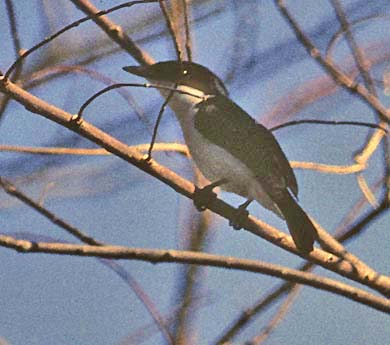 More
than 24 million years ago in tropical Africa, a lineage of shrike-like
birds diverged from their nearest corvoid ancestors. We don't actually
know what they looked like then, but within 4 million years they were
quite diverse and some of them found their way over the Indian Ocean to
Madagascar (Reddy et al. 2012). They arrived there before many other
landbirds had arrived and found a bountiful supply of diverse habitats.
Like Galapagos finches and Hawaiian honeycreepers, the birds exploited
open niches within the habitats and rather quickly in evolutionary time
produced distinctive lineages that became today's 21 species of vangas
(Jønsson et al. 2012). The African continental birds did not
evolve nearly as much, but they became today's helmetshrikes,
shrike-flycatchers and relatives. One of these is today's Retz's Helmetshrike
(above). Others from the lineage made their way to southern Asia —
either through the Middle East or via cross-oceanic flights from
Madagascar, we don't know which (Reddy et al. 2012) — and evolved there
into a set of smallish flycatcher, one of which is today's Black-winged Flycatcher-shrike (right). More
than 24 million years ago in tropical Africa, a lineage of shrike-like
birds diverged from their nearest corvoid ancestors. We don't actually
know what they looked like then, but within 4 million years they were
quite diverse and some of them found their way over the Indian Ocean to
Madagascar (Reddy et al. 2012). They arrived there before many other
landbirds had arrived and found a bountiful supply of diverse habitats.
Like Galapagos finches and Hawaiian honeycreepers, the birds exploited
open niches within the habitats and rather quickly in evolutionary time
produced distinctive lineages that became today's 21 species of vangas
(Jønsson et al. 2012). The African continental birds did not
evolve nearly as much, but they became today's helmetshrikes,
shrike-flycatchers and relatives. One of these is today's Retz's Helmetshrike
(above). Others from the lineage made their way to southern Asia —
either through the Middle East or via cross-oceanic flights from
Madagascar, we don't know which (Reddy et al. 2012) — and evolved there
into a set of smallish flycatcher, one of which is today's Black-winged Flycatcher-shrike (right).
Many
of these birds were traditionally assigned to different bird families.
Fourteen were considered vangas, endemic to Madagascar, but others were
thought related to batises, or monarchs, or cuckooshrikes, or ioras. It
has only just been sorted out. This clade has three major groups (click
on the photo or name for a separate page): |
|
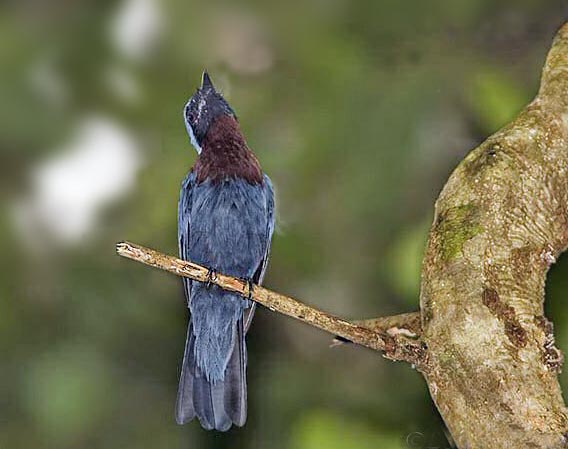 Each
of these three major groups has been considered a separate family,
including on earlier versions of the this Family list. In fact,
helmetshrikes have traditionally been considered more closely related
to bush-shrikes. But the molecular evidence shows they are all within
the same lineage. There is also one other genus within this lineage:
two species of "flycatchers" in south Asia called philentomas (genus Philentoma). Maroon-breasted Philentoma
(left, in a very fine and difficult photo © Leif Gabrielsen) is
primarily a canopy species — hard to see, harder to photograph — where
it is quiet and often lethargic, not moving for long periods of time as
it searches visually for prey. Each
of these three major groups has been considered a separate family,
including on earlier versions of the this Family list. In fact,
helmetshrikes have traditionally been considered more closely related
to bush-shrikes. But the molecular evidence shows they are all within
the same lineage. There is also one other genus within this lineage:
two species of "flycatchers" in south Asia called philentomas (genus Philentoma). Maroon-breasted Philentoma
(left, in a very fine and difficult photo © Leif Gabrielsen) is
primarily a canopy species — hard to see, harder to photograph — where
it is quiet and often lethargic, not moving for long periods of time as
it searches visually for prey.
It is still unclear
where in vangid lineage they arose. The paper by Reddy et al. (2012)
found that the genus was sister to vangas using "maximum likelihood" or
"Bayesian" assumptions in the computerized analysis, but not so within
"maximum parsimony" assumptions. However, working separately,
Jønsson et al. (2012) also found the Philetoma was
sister to the Madagascan vangas, so the two papers generally agree that
Asian philentomas are the closest living relative to Malagasy vangas.
|
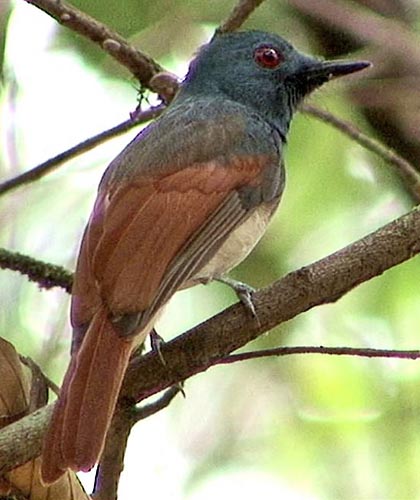 Today's vangids are thus composed of 21 vangas (see separate page for more details), 8 helmetshrikes (separate page), the 4 woodshrikes plus 2 shrike-flycatchers plus 2 flycatcher-shrikes (separate page),
and two 2 philentomas . The same evidence that places them as a single
lineage of 24.4 million years could be used to construct 3 or 4
separate families. The three major clades (each having a separate page
here) could be considered families, as they did diverge about 20
million years ago, so each is an ancient lineage. It is the genus Philentoma
that makes it difficult. Does one rely on "maximum likelihood" or
"Bayesian inference" assumptions and put them with Vangas? Does one
place them in a separate family? These are not currently answerable
questions. Given the uncertainty, it seems better for the moment to
consider all three clades, plus the two Philentomas, to be
"vangids" in an expanded Vangidae. Birders, though, will wish to locate
and observe examples of each of these divergent sets. Today's vangids are thus composed of 21 vangas (see separate page for more details), 8 helmetshrikes (separate page), the 4 woodshrikes plus 2 shrike-flycatchers plus 2 flycatcher-shrikes (separate page),
and two 2 philentomas . The same evidence that places them as a single
lineage of 24.4 million years could be used to construct 3 or 4
separate families. The three major clades (each having a separate page
here) could be considered families, as they did diverge about 20
million years ago, so each is an ancient lineage. It is the genus Philentoma
that makes it difficult. Does one rely on "maximum likelihood" or
"Bayesian inference" assumptions and put them with Vangas? Does one
place them in a separate family? These are not currently answerable
questions. Given the uncertainty, it seems better for the moment to
consider all three clades, plus the two Philentomas, to be
"vangids" in an expanded Vangidae. Birders, though, will wish to locate
and observe examples of each of these divergent sets.
Both Marron-breasted Philetoma and Rufous-winged Philentoma
(right in a nice photo by Josef Del Hoyo of HBW fame) are found on the
Malay Peninsula, Sumatra, and Borneo, with Maroon-breasted also on
Java. The Rufous-winged Philentoma is also reclusive, sitting quietly
in the shadows of the understory.
Until the recent
molecular analyses of Reddy et al. (2012) and Jønsson et al.
(2012), no one guessed that they were evolved from African shrike-like
birds, let alone the vangas of Madagascar! |
Photos: The Black-winged Flycatcher-Shrike Hemipus hirundinaceus was at Baluran NP, Java, Indonesia, on 31 Aug 1988. The White Helmetshrike Prionops plumatus was photographed in Kruger Nat'l Park, South Africa, on 28 July 1996. The Van Dam's Vanga Xenopirostris damii was photographed at Ankarafantsika in the Ampijoroa Forest on 29 Nov 1992. The Common Woodshrike Tephrodornis pondicerianus was at Sultanpur Jheel, Haranya, India, on 11 Mar 2001. Leif Gabrielsen photographed the Maroon-breasted Philentoma Philentoma velata at Poring Springs, Borneo, in Sabah, Malaysia, in Sep 2005. The Rufous-winged Philentoma P. pryhoptera was photographed by Joself del Hoyo at Locality Khao Nor Chuchi, Thailand, on 7 Apr 2008. Photos © D. Roberson, except the philentomsa © Leif Gabrielsen and © Josef del Hopo, and used with permission; all rights reserved.
Bibliographic note: There is no "family book" per se but the Handbook of the Birds of the World
series covers all the species, and has spectacular introductions to the
(now) subfamilies of helmetshrikes (Allan 2009) and vangas (Yamagishi
& Nakamura 2009).
Literature cited:
Allan, D.A. 2009. Family Prionopidae (Helmet-shrikes), pp. 124 –141 in
Handbook of the Birds of the World (del Hoyo, J., A. Elliott & D.A.
Christie, eds). Vol. 14. Lynx Edicions, Barcelona, Spain.
Jønsson,
K.A., P-H. Fabre, S.A. Fritz, R.S. Etienne, R.E. Ricklefs, T.B.
Jørgensen, J. Fjeldså, C. Rahbek, P.G.P. Ericson, F. Woog,
E. Pasquet, and M. Irestedt. 2012. Ecologoical and evolutionary
determinants for the adaptive radiation of the Madagascan vangas. PNAS:
1115835109.
Reddy,
S., A. Driskell, D.L. Rabosky, S.J. Hackett, and T.S. Schulenberg.
2012. Diversification and the adaptive radiation of the vangas of
Madagascar, Proc. Royal Soc. B 279: 2062-2071.
Yamagishi, S., and M. Nakamura. 2009. Family Vangidae (Vangas), pp. 142 –171 in
Handbook of the Birds of the World (del Hoyo, J., A. Elliott & D.A.
Christie, eds). Vol. 14. Lynx Edicions, Barcelona, Spain.
|
|
|

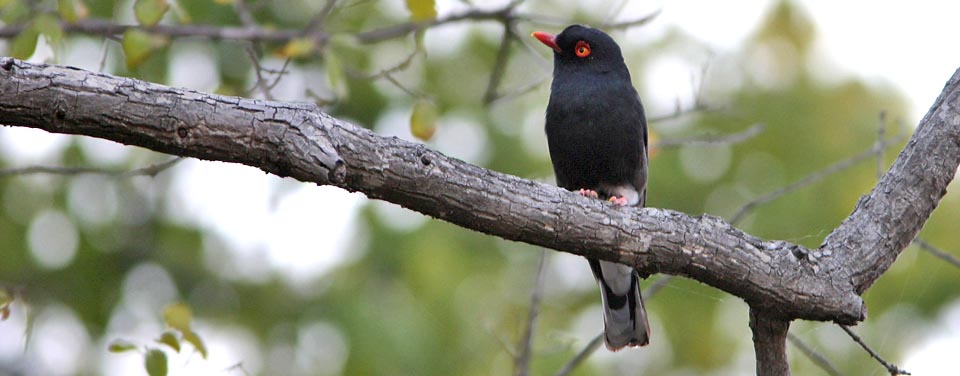
 More
than 24 million years ago in tropical Africa, a lineage of shrike-like
birds diverged from their nearest corvoid ancestors. We don't actually
know what they looked like then, but within 4 million years they were
quite diverse and some of them found their way over the Indian Ocean to
Madagascar (Reddy et al. 2012). They arrived there before many other
landbirds had arrived and found a bountiful supply of diverse habitats.
Like Galapagos finches and Hawaiian honeycreepers, the birds exploited
open niches within the habitats and rather quickly in evolutionary time
produced distinctive lineages that became today's 21 species of vangas
(Jønsson et al. 2012). The African continental birds did not
evolve nearly as much, but they became today's helmetshrikes,
shrike-flycatchers and relatives. One of these is today's Retz's Helmetshrike
(above). Others from the lineage made their way to southern Asia —
either through the Middle East or via cross-oceanic flights from
Madagascar, we don't know which (Reddy et al. 2012) — and evolved there
into a set of smallish flycatcher, one of which is today's Black-winged Flycatcher-shrike (right).
More
than 24 million years ago in tropical Africa, a lineage of shrike-like
birds diverged from their nearest corvoid ancestors. We don't actually
know what they looked like then, but within 4 million years they were
quite diverse and some of them found their way over the Indian Ocean to
Madagascar (Reddy et al. 2012). They arrived there before many other
landbirds had arrived and found a bountiful supply of diverse habitats.
Like Galapagos finches and Hawaiian honeycreepers, the birds exploited
open niches within the habitats and rather quickly in evolutionary time
produced distinctive lineages that became today's 21 species of vangas
(Jønsson et al. 2012). The African continental birds did not
evolve nearly as much, but they became today's helmetshrikes,
shrike-flycatchers and relatives. One of these is today's Retz's Helmetshrike
(above). Others from the lineage made their way to southern Asia —
either through the Middle East or via cross-oceanic flights from
Madagascar, we don't know which (Reddy et al. 2012) — and evolved there
into a set of smallish flycatcher, one of which is today's Black-winged Flycatcher-shrike (right). 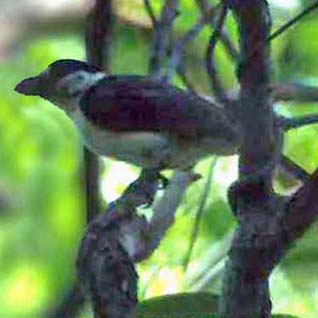
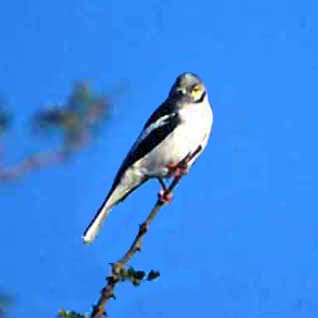
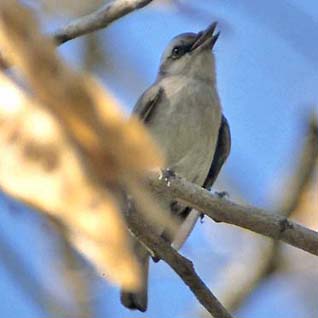
 Each
of these three major groups has been considered a separate family,
including on earlier versions of the this Family list. In fact,
helmetshrikes have traditionally been considered more closely related
to bush-shrikes. But the molecular evidence shows they are all within
the same lineage. There is also one other genus within this lineage:
two species of "flycatchers" in south Asia called philentomas (genus Philentoma). Maroon-breasted Philentoma
(left, in a very fine and difficult photo © Leif Gabrielsen) is
primarily a canopy species — hard to see, harder to photograph — where
it is quiet and often lethargic, not moving for long periods of time as
it searches visually for prey.
Each
of these three major groups has been considered a separate family,
including on earlier versions of the this Family list. In fact,
helmetshrikes have traditionally been considered more closely related
to bush-shrikes. But the molecular evidence shows they are all within
the same lineage. There is also one other genus within this lineage:
two species of "flycatchers" in south Asia called philentomas (genus Philentoma). Maroon-breasted Philentoma
(left, in a very fine and difficult photo © Leif Gabrielsen) is
primarily a canopy species — hard to see, harder to photograph — where
it is quiet and often lethargic, not moving for long periods of time as
it searches visually for prey.  Today's vangids are thus composed of 21 vangas (see
Today's vangids are thus composed of 21 vangas (see